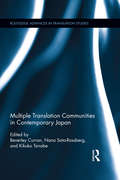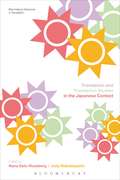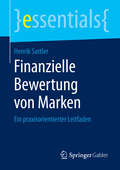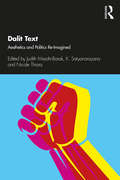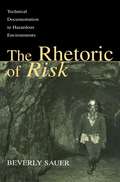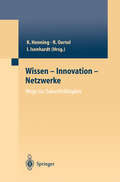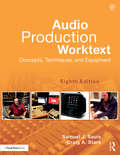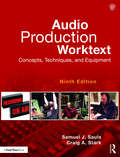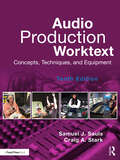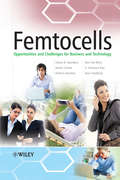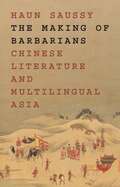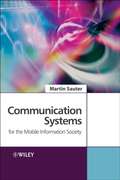- Table View
- List View
Multiple Translation Communities in Contemporary Japan (Routledge Advances in Translation and Interpreting Studies)
by Nana Sato-Rossberg Beverley Curran Kikuko TanabeMultiple Translation Communities in Contemporary Japan offers a collection of essays that (1) deepens the understanding of the cultural and linguistic diversity of communities in contemporary Japan and how translation operates in this shifting context and circulates globally by looking at some of the ways it is theorized and approached as a significant social, cultural, or political practice, and harnessed by its multiple agents; (2) draws attention to the multi-platform translations of cultural productions such as manga, which are both particular to and popular in Japan but also culturally influential and widely circulated transnationally; (3) poses questions about the range of roles translation has in the construction, performance, and control of gender roles in Japan, and (4) enriches Translation Studies by offering essays that problematize critical notions related to translation. In short, the essays in this book highlight the diversity and ubiquity of translation in Japan as well as the range of methods being used to understand how it is being theorized, positioned, and practiced.
Multiple Translation Communities in Contemporary Japan (Routledge Advances in Translation and Interpreting Studies)
by Nana Sato-Rossberg Beverley Curran Kikuko TanabeMultiple Translation Communities in Contemporary Japan offers a collection of essays that (1) deepens the understanding of the cultural and linguistic diversity of communities in contemporary Japan and how translation operates in this shifting context and circulates globally by looking at some of the ways it is theorized and approached as a significant social, cultural, or political practice, and harnessed by its multiple agents; (2) draws attention to the multi-platform translations of cultural productions such as manga, which are both particular to and popular in Japan but also culturally influential and widely circulated transnationally; (3) poses questions about the range of roles translation has in the construction, performance, and control of gender roles in Japan, and (4) enriches Translation Studies by offering essays that problematize critical notions related to translation. In short, the essays in this book highlight the diversity and ubiquity of translation in Japan as well as the range of methods being used to understand how it is being theorized, positioned, and practiced.
Translation and Translation Studies in the Japanese Context (Continuum Advances in Translation)
by Nana Sato-Rossberg Judy WakabayashiJapan is often regarded as a 'culture of translation'. Oral and written translation has played a vital role in Japan over the centuries and led to a formidable body of thinking and research. This is rooted in a context about which little information has been available outside of Japan in the past. The chapters examine the current state of translation studies as an academic discipline in Japan and a range of historical aspects (for example, translation of Chinese vernacular novels in early modern times, the role of translation in Japan's modernization, changes in stylistic norms in Meiji-period translations, 'thick translation' of indigenous Ainu place names), as well as creative aspects of translation in modern and postwar Japan. Other chapters explore contemporary phenomena such as the intralingual translation of Japanese expressions embedded in English texts emanating from diasporic contexts, the practice of pre-translation or writing for an international audience from the outset, the innovative practice of reverse localization of Japanese video games back into Japanese, and community interpreting practices and research.
Translation and Translation Studies in the Japanese Context (Continuum Advances in Translation)
by Nana Sato-Rossberg Judy WakabayashiJapan is often regarded as a 'culture of translation'. Oral and written translation has played a vital role in Japan over the centuries and led to a formidable body of thinking and research. This is rooted in a context about which little information has been available outside of Japan in the past. The chapters examine the current state of translation studies as an academic discipline in Japan and a range of historical aspects (for example, translation of Chinese vernacular novels in early modern times, the role of translation in Japan's modernization, changes in stylistic norms in Meiji-period translations, 'thick translation' of indigenous Ainu place names), as well as creative aspects of translation in modern and postwar Japan. Other chapters explore contemporary phenomena such as the intralingual translation of Japanese expressions embedded in English texts emanating from diasporic contexts, the practice of pre-translation or writing for an international audience from the outset, the innovative practice of reverse localization of Japanese video games back into Japanese, and community interpreting practices and research.
Modernist Magazines and the Social Ideal
by Tim SatterthwaiteThe new photo-illustrated magazines of the 1920s traded in images of an ideal modernity, promising motorised leisure, scientific progress, and social and sexual emancipation. Modernist Magazines and the Social Ideal is a pioneering history of these periodicals, focusing on two of the leading European titles: the German monthly UHU, and the French news weekly VU, taken as representative of the broad class of popular titles launched in the 1920s. The book is the first major study of UHU, and the first scholarly work on VU in English. The book explores, in particular, the striking use of regularity and repetition in photographs of modernity, reading these repetitious images as symbolic of modernist ideals of social order in the aftermath of the First World War. Alongside the UHU and VU case studies, Modernist Magazines offers an essential primer to interwar magazine culture in Europe. Accounts of rival titles are woven into the book's thematic chapters, which trace the evolution of the two magazines' photography and graphic design in the tumultuous years up to 1933.
Modernist Magazines and the Social Ideal (Criminal Practice Ser.)
by Tim SatterthwaiteThe new photo-illustrated magazines of the 1920s traded in images of an ideal modernity, promising motorised leisure, scientific progress, and social and sexual emancipation. Modernist Magazines and the Social Ideal is a pioneering history of these periodicals, focusing on two of the leading European titles: the German monthly UHU, and the French news weekly VU, taken as representative of the broad class of popular titles launched in the 1920s. The book is the first major study of UHU, and the first scholarly work on VU in English. The book explores, in particular, the striking use of regularity and repetition in photographs of modernity, reading these repetitious images as symbolic of modernist ideals of social order in the aftermath of the First World War. Alongside the UHU and VU case studies, Modernist Magazines offers an essential primer to interwar magazine culture in Europe. Accounts of rival titles are woven into the book's thematic chapters, which trace the evolution of the two magazines' photography and graphic design in the tumultuous years up to 1933.
Finanzielle Bewertung von Marken: Ein praxisorientierter Leitfaden (essentials)
by Henrik SattlerHenrik Sattler erklärt praxisnah und wissenschaftlich fundiert, wie Marken finanziell bewertet werden sollten. Wer eine Marke kaufen, eine Markenlizenz erwerben oder den Erfolg einer Markenkampagne finanziell messen will, muss dafür einen gesicherten monetären Wert bestimmen können. Auch für Schadensersatzbestimmungen bei Markenrechtsverletzungen sowie für die Einstellung von Marken in die Bilanz oder ihre Verwendung als Kreditsicherung muss zwingend ein Markenwert messbar sein. Der Autor entwickelt einen Leitfaden, der zehn entscheidende Punkte für die Bewertung von Marken beinhaltet, und ergänzt seine Ausführungen durch anschauliche Praxisbeispiele.
Dalit Text: Aesthetics and Politics Re-imagined
by K. Satyanarayana Judith Misrahi-Barak Nicole ThiaraThis book, companion to the much-acclaimed Dalit Literatures in India, examines questions of aesthetics and literary representation in a wide range of Dalit literary texts. It looks at how Dalit literature, born from the struggle against social and political injustice, invokes the rich and complex legacy of oral, folk and performative traditions of marginalised voices. The essays and interviews systematically explore a range of literary forms, from autobiographies, memoirs and other testimonial narratives, to poems, novels or short stories, foregrounding the diversity of Dalit creation. Showcasing the interplay between the aesthetic and political for a genre of writing that has ‘change’ as its goal, the volume aims to make Dalit writing more accessible to a wider public, for the Dalit voices to be heard and understood. The volume also shows how the genre has revolutionised the concept of what literature is supposed to mean and define. Effervescent first-person accounts, socially militant activism and sharp critiques of a little-explored literary terrain make this essential reading for scholars and researchers of social exclusion and discrimination studies, literature (especially comparative literature), translation studies, politics, human rights and culture studies.
The Rhetoric of Risk: Technical Documentation in Hazardous Environments (Rhetoric, Knowledge, and Society Series)
by Beverly A. SauerThe crash of an Amtrak train near Baltimore, the collapse of the Hyatt hotel in Kansas City, the incident at Three Mile Island, and other large-scale technological disasters have provided powerful examples of the ways that communication practices influence the events and decisions that precipitate a disaster. These examples have raised ethical questions about the responsibility of writers within agencies, epistemological questions about the nature of representation in science, and rhetorical questions about the nature of expertise and experience as grounds for judgments about risk. In The Rhetoric of Risk: Technical Documentation in Hazardous Environments, author Beverly Sauer examines how the dynamic uncertainty of the material environment affects communication in large regulatory industries. Sauer's analysis focuses specifically on mine safety, which provides a rich technical and historical context where problems of rhetorical agency, narrative, and the negotiation of meaning have visible and tragic outcomes. But the questions Sauer asks have larger implication for risk and safety: How does writing function in large regulatory industries? What can we learn from experience? Why is this experience so difficult to capture in writing? What information is lost when agencies rely on written documentation alone? Given the uncertainties, how can we work to improve communication in hazardous and uncertain environments? By exploring how individuals make sense of the material, technical, and institutional indeterminancies of their work in speech and gesture, The Rhetoric of Risk helps communicators rethink their frequently unquestioned assumptions about workplace discourse and the role of writers in hazardous worksites. It is intended for scholars and students in technical writing and communication, rhetoric, risk analysis and risk communication, as well as a wide range of engineering and technical fields concerned with risk, safety, and uncertainty.
The Rhetoric of Risk: Technical Documentation in Hazardous Environments (Rhetoric, Knowledge, and Society Series)
by Beverly A. SauerThe crash of an Amtrak train near Baltimore, the collapse of the Hyatt hotel in Kansas City, the incident at Three Mile Island, and other large-scale technological disasters have provided powerful examples of the ways that communication practices influence the events and decisions that precipitate a disaster. These examples have raised ethical questions about the responsibility of writers within agencies, epistemological questions about the nature of representation in science, and rhetorical questions about the nature of expertise and experience as grounds for judgments about risk. In The Rhetoric of Risk: Technical Documentation in Hazardous Environments, author Beverly Sauer examines how the dynamic uncertainty of the material environment affects communication in large regulatory industries. Sauer's analysis focuses specifically on mine safety, which provides a rich technical and historical context where problems of rhetorical agency, narrative, and the negotiation of meaning have visible and tragic outcomes. But the questions Sauer asks have larger implication for risk and safety: How does writing function in large regulatory industries? What can we learn from experience? Why is this experience so difficult to capture in writing? What information is lost when agencies rely on written documentation alone? Given the uncertainties, how can we work to improve communication in hazardous and uncertain environments? By exploring how individuals make sense of the material, technical, and institutional indeterminancies of their work in speech and gesture, The Rhetoric of Risk helps communicators rethink their frequently unquestioned assumptions about workplace discourse and the role of writers in hazardous worksites. It is intended for scholars and students in technical writing and communication, rhetoric, risk analysis and risk communication, as well as a wide range of engineering and technical fields concerned with risk, safety, and uncertainty.
Audio Production Worktext: Concepts, Techniques, and Equipment
by Samuel J. Sauls Craig A. StarkThis is an excellent introduction to the modern radio production studio, the equipment found in that studio, and the basic techniques needed to accomplish radio production work. The new edition is updated throughout and features new sections on mobile technology, audio editing apps and software, and digital editing, as well as updated graphics and expanded content on portable digital audio players. Features a worktext/website format tailored for both students and teachers, offering a solid foundation for anyone who wishes to know more about radio/audio equipment and production techniques.
Audio Production Worktext: Concepts, Techniques, and Equipment
by Samuel J. Sauls Craig A. StarkThis is an excellent introduction to the modern radio production studio, the equipment found in that studio, and the basic techniques needed to accomplish radio production work. The new edition is updated throughout and features new sections on mobile technology, audio editing apps and software, and digital editing, as well as updated graphics and expanded content on portable digital audio players. Features a worktext/website format tailored for both students and teachers, offering a solid foundation for anyone who wishes to know more about radio/audio equipment and production techniques.
Audio Production Worktext: Concepts, Techniques, and Equipment
by Samuel J. Sauls Craig A. StarkAudio Production Worktext, 9th Edition provides readers the best introduction to audio and radio production. It shows how to navigate modern radio production studios and utilize the latest equipment and software. The 9th edition is updated to cover new mobile technologies, digital consoles, and audio editing apps and software, as well sound for the visual media and Internet radio. The new edition continues to include the worktext/website format tailored for both students and teachers and features like Production Tips that provide notes relevant to various audio production topics, self-study questions and projects, an updated Glossary, and an up-to-date companion website with invaluable student and instructor materials. Included in this edition are offers and features from Pro Sound Effects, FilmTVsound.com, and RadioFX, as well as updated color graphics and images throughout the text.
Audio Production Worktext: Concepts, Techniques, and Equipment
by Samuel J. Sauls Craig A. StarkAudio Production Worktext, 9th Edition provides readers the best introduction to audio and radio production. It shows how to navigate modern radio production studios and utilize the latest equipment and software. The 9th edition is updated to cover new mobile technologies, digital consoles, and audio editing apps and software, as well sound for the visual media and Internet radio. The new edition continues to include the worktext/website format tailored for both students and teachers and features like Production Tips that provide notes relevant to various audio production topics, self-study questions and projects, an updated Glossary, and an up-to-date companion website with invaluable student and instructor materials. Included in this edition are offers and features from Pro Sound Effects, FilmTVsound.com, and RadioFX, as well as updated color graphics and images throughout the text.
Audio Production Worktext: Concepts, Techniques, and Equipment
by Samuel J. Sauls Craig A. StarkNow in its tenth edition, the Audio Production Worktext offers a comprehensive introduction to audio production in radio, television, and film. This hands-on, student-friendly text demonstrates how to navigate modern radio production studios and utilize the latest equipment and software. Key chapters address production planning, the use of microphones, audio consoles, and sound production for the visual media. The reader is shown the reality of audio production both within the studio and on location. New to this edition is material covering podcasting, including online storage and distribution. The new edition also includes an updated glossary and appendix on analog and original digital applications, as well as self-study questions and projects that students can use to further enhance their learning. The accompanying instructor website has been refreshed and includes an instructor’s manual and PowerPoint images. This book remains an essential text for audio and media production students seeking a thorough introduction to the field.
Audio Production Worktext: Concepts, Techniques, and Equipment
by Samuel J. Sauls Craig A. StarkNow in its tenth edition, the Audio Production Worktext offers a comprehensive introduction to audio production in radio, television, and film. This hands-on, student-friendly text demonstrates how to navigate modern radio production studios and utilize the latest equipment and software. Key chapters address production planning, the use of microphones, audio consoles, and sound production for the visual media. The reader is shown the reality of audio production both within the studio and on location. New to this edition is material covering podcasting, including online storage and distribution. The new edition also includes an updated glossary and appendix on analog and original digital applications, as well as self-study questions and projects that students can use to further enhance their learning. The accompanying instructor website has been refreshed and includes an instructor’s manual and PowerPoint images. This book remains an essential text for audio and media production students seeking a thorough introduction to the field.
Marketing in the Boardroom: Winning the Hearts and Minds of the Board
by Ruth SaundersIt’s no secret: marketing punches below its weight in the Boardroom. CEOs and other board members perceive that marketers lack commercial credibility when compared to their peers. Marketing in the Boardroom helps marketers to be more commercially credible and thereby more successful in the Boardroom. Ruth Saunders explains the importance of marketing in the Boardroom, and why marketers often struggle to engage the Board. She then shows how to develop compelling marketing strategies that the Board will buy into, offering a mix of practical solutions and varied case studies drawn from her years of industry experience. In the final section, she helps marketers better understand the Board mindset and language, demonstrating how to win over the Board members’ hearts, minds and confidence. Marketing in the Boardroom is an important book for any aspiring marketers who are moving up the career ladder, particularly those who are writing or giving presentations to the Board. It is also an important book for their organizations, particularly those that struggle to give marketing the support it needs to create customer-led strategies that will drive business growth.
Marketing in the Boardroom: Winning the Hearts and Minds of the Board
by Ruth SaundersIt’s no secret: marketing punches below its weight in the Boardroom. CEOs and other board members perceive that marketers lack commercial credibility when compared to their peers. Marketing in the Boardroom helps marketers to be more commercially credible and thereby more successful in the Boardroom. Ruth Saunders explains the importance of marketing in the Boardroom, and why marketers often struggle to engage the Board. She then shows how to develop compelling marketing strategies that the Board will buy into, offering a mix of practical solutions and varied case studies drawn from her years of industry experience. In the final section, she helps marketers better understand the Board mindset and language, demonstrating how to win over the Board members’ hearts, minds and confidence. Marketing in the Boardroom is an important book for any aspiring marketers who are moving up the career ladder, particularly those who are writing or giving presentations to the Board. It is also an important book for their organizations, particularly those that struggle to give marketing the support it needs to create customer-led strategies that will drive business growth.
Femtocells: Opportunities and Challenges for Business and Technology (Telecoms Explained)
by Simon R. Saunders Stuart Carlaw Andrea Giustina Ravi Rai Bhat V. Srinivasa Rao Rasa SiegbergFemtocells are low-power wireless access points used in the home and office. They operate in licensed spectrum to connect standard mobile phones (WCDMA, LTE, WiMAX, CDMA and GSM) and other mobile devices to a mobile operator’s network via standard broadband internet connections. This technology is of high interest for mobile operators and for millions of users who will benefit from enhanced access to mobile broadband services. Femtocells outlines how wireless access points can be used by mobile operators to provide high-speed wireless access, enhancing coverage and capacity and delivering entirely new services, while maximising the benefits of licensed spectrum. The book examines the market, exploring commercial and technical factors which are critical in the initial deployment and long-term success of femtocells. Business, standards and regulatory aspects are also considered to provide a complete but concise overview. One of the first authoritative texts to concentrate on femtocells Written by expert authors from industry including leading analysts, femtocell and system vendors Covers both technology and business aspects in detail Provides overview of the relevant standards across WCDMA, LTE, CDMA, WiMAX and GSM air interfaces
The Making of Barbarians: Chinese Literature and Multilingual Asia (Translation/Transnation #58)
by Haun SaussyA groundbreaking account of translation and identity in the Chinese literary tradition before 1850—with important ramifications for todayDebates on the canon, multiculturalism, and world literature often take Eurocentrism as the target of their critique. But literature is a universe with many centers, and one of them is China. The Making of Barbarians offers an account of world literature in which China, as center, produces its own margins. Here Sinologist and comparatist Haun Saussy investigates the meanings of literary translation, adaptation, and appropriation on the boundaries of China long before it came into sustained contact with the West.When scholars talk about comparative literature in Asia, they tend to focus on translation between European languages and Chinese, Korean, and Japanese, as practiced since about 1900. In contrast, Saussy focuses on the period before 1850, when the translation of foreign works into Chinese was rare because Chinese literary tradition overshadowed those around it.The Making of Barbarians looks closely at literary works that were translated into Chinese from foreign languages or resulted from contact with alien peoples. The book explores why translation was such an undervalued practice in premodern China, and how this vast and prestigious culture dealt with those outside it before a new group of foreigners—Europeans—appeared on the horizon.
Beyond 3G - Bringing Networks, Terminals and the Web Together: LTE, WiMAX, IMS, 4G Devices and the Mobile Web 2.0
by Martin SauterGiving a sound technical introduction to 3GPP LTE and SAE, this book explains the decisions taken during standardization while also examining the likely competition for LTE such as HSPA+ and WiMAX. As well as looking at next generation network technologies, Beyond 3G - Bringing Networks, Terminals and the Web Together describes the latest mobile device developments, voice and multimedia services and the mobile web 2.0. It considers not only how the systems, devices and software work but also the reasons behind why they are designed in this particular way. How these elements strongly influence each other is discussed as well as how network capabilities, available bandwidth, mobile device capabilities and new application concepts will shape the way we communicate in the future. This book gives an end to end introduction to wireless, from mobile software architecture to core networks, making it a valuable resource for anyone working in the industry. Examines current and next-generation network technologies such as UMTS, HSPA+, WiMAX, LTE and Wifi Analyses and explains performance and capacity in practice as well as future capacity requirements and how they can be fulfilled Introduces the reader to the current cellular telephony architecture and to voice over IP architectures such as SIP, IMS and TISPAN Looks at mobile device hardware and mobile operating system evolution Encompasses all major global wireless standards for application development and the latest state of the mobile web 2.0
Beyond 3G - Bringing Networks, Terminals and the Web Together: LTE, WiMAX, IMS, 4G Devices and the Mobile Web 2.0
by Martin SauterGiving a sound technical introduction to 3GPP LTE and SAE, this book explains the decisions taken during standardization while also examining the likely competition for LTE such as HSPA+ and WiMAX. As well as looking at next generation network technologies, Beyond 3G - Bringing Networks, Terminals and the Web Together describes the latest mobile device developments, voice and multimedia services and the mobile web 2.0. It considers not only how the systems, devices and software work but also the reasons behind why they are designed in this particular way. How these elements strongly influence each other is discussed as well as how network capabilities, available bandwidth, mobile device capabilities and new application concepts will shape the way we communicate in the future. This book gives an end to end introduction to wireless, from mobile software architecture to core networks, making it a valuable resource for anyone working in the industry. Examines current and next-generation network technologies such as UMTS, HSPA+, WiMAX, LTE and Wifi Analyses and explains performance and capacity in practice as well as future capacity requirements and how they can be fulfilled Introduces the reader to the current cellular telephony architecture and to voice over IP architectures such as SIP, IMS and TISPAN Looks at mobile device hardware and mobile operating system evolution Encompasses all major global wireless standards for application development and the latest state of the mobile web 2.0
Communication Systems for the Mobile Information Society
by Martin SauterMany wireless systems like GSM, GPRS, UMTS, Bluetooth, WLAN or WiMAX offer possibilities to keep people connected while on the move. In this flood of technology and claims that one single resource will serve all our needs, this book seeks to enable readers to examine and understand each technology, and how to utilise several different systems for the best results. Communication Systems for the Mobile Information Society not only contains a technical description of the different wireless systems available today, but also explains the thoughts that are behind the different mechanisms and implementations; not only the 'how' but also the 'why' is in focus. Thus the advantages and also limitations of each technology become apparent. Provides readers with a solid introduction to major global wireless standards and compares the different wireless technologies and their applications Describes the different systems based on the standards, their practical implementation and the design assumptions that were made The performance and capacity of each system in practice is analyzed and explained, accompanied with practical tips on how to discover the functionality of different networks by the readers themselves Questions at the end of each chapter and answers on the accompanying website make this book ideal for self study or as course material Illustrated with many realistic examples of how mobile people can stay in touch with other people, the Internet and their corporate intranet This book is an essential resource for telecommunication engineers, professionals and computer science and electrical engineering students who want to get a thorough end-to-end understanding of the different technical concepts of the systems on the market today.
From GSM to LTE-Advanced Pro and 5G: An Introduction to Mobile Networks and Mobile Broadband
by Martin SauterA comparative introduction to major global wireless standards, technologies and their applications From GSM to LTE-Advanced Pro and 5G: An Introduction to Mobile Networks and Mobile Broadband, 3rd Edition provides technical descriptions of the various wireless technologies currently in use. It explains the rationales behind their differing mechanisms and implementations while exploring the advantages and limitations of each technology. This edition has been fully updated and substantially expanded to reflect the significant evolution in mobile network technology occurring over the past several years. The chapter on LTE has been extensively enhanced with new coverage of current implementations of LTE carrier aggregation, mobility management, cell reselection and handover procedures, as well as the latest developments in 5G radio and core networks in 3GPP. It now features additional information on the TD-LTE air interface, IPv6 in mobile networks, Network Function Virtualization (NFV) and Narrowband Internet of Things (NB-IOT). Voice-over-LTE (VoLTE) is now treated extensively in a separate chapter featuring coverage of the VoLTE call establishment process, dedicated bearer setup, header compression, speech codec and bandwidth negotiation, supplementary service configuration and VoLTE emergency calls. In addition, extensive coverage of Voice-over-Wifi and mission critical communication for public safety organizations over LTE has been added. The WLAN chapter now provides coverage of WPA2-Professional with certificates for authentication in large deployments, such as the global Eduroam network and the new WLAN 60 GHz air interface. Bluetooth evolution has been addressed by including a detailed description of Bluetooth Low Energy (BLE) in the chapter devoted to Bluetooth. Describes the different systems based on the standards, their practical implementation and design assumptions, and the performance and capacity of each system in practice is analyzed and explained Questions at the end of each chapter and answers on the accompanying website make this book ideal for self-study or as course material.
